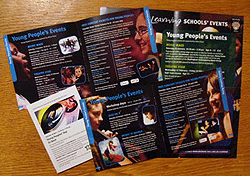English
No.4 Music and Manga
One of the programmes for young people in the Autumn-Winter season of Wigmore Hall Learning attracted my attention. It was called 'Music 'N' Manga'. Why did they choose Manga as a theme? How did they combine music and Manga during the workshop?
Title: Young People's Day 'MUSIC 'N' MANGA'
Date: Saturday, 14th November, 2009 10:00-15:30
Venue: Wigmore Hall Bechstein Room, Hall
Ensemble: Ignite <Jackie Walduck (leader, composer, percussionist),Daniel Parkin (flute) ,Julian Ferraretto (violin),Andy Hamill (double bass)>+Kate Newell (Wigmore Hall trainee animateur, oboe)
Target: 11-16 years old
Fee: £10 per person

Manga section of a bookshop in London,
occupying 4 shelves
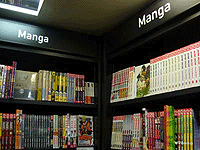
Speccially allocated for 'Manga'
One of the hardest educational programmes are those designed for young people. To attract young people, whose interests change quickly, Wigmore Hall Learning devises various musical events, including collaborations with different genres: Jazz, DJing, animation, Manga, and so on. I asked Elizabeth from the Learning Team why they chose Manga as the theme of the programme.
She said, 'We are trying to engage young people by presenting music combined with various genres of art from various cultures. Of course, we have had Japanese music in the concerts, but we have never dealt with Japanese culture as a Learning event. And Manga is very popular among the young people in London nowadays'.
Although they decided to feature Manga, they had never dealt with it before. 'I asked my friends of music circle but, because nobody had held events involving music and Manga, they had no idea about it. Then I heard that there was an artist who had given Manga workshops in London. That was how we found Chie'.
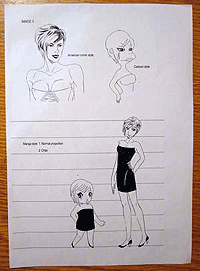
Material used during the workshop
Chie Kutsuwada, the workshop leader of the Manga part, is a London-based Manga artist and illustrator. As she is a Japanese Manga artist living in London, with a background in fine arts, she not only writes Manga but is also invited to act as a tutor at local schools and centres. She said, 'Sometimes I go to an art class and give workshops on drawing Manga, and sometimes I introduce Manga as Japanese culture to a class for cross-cultural understanding. Unlike Japan, where children and adults from various social statuses enjoy reading Manga, people who have access to Manga in the UK tend to be of a higher social class with a higher level of interest in it, and the majority of the readers are teenagers. Interest in Japanese culture, especially Japanese language has been increasing recently. I was amazed by the fact that the Manga I wrote in bilingual language (lines are written both in English and Japanese in a word-balloon) were appreciated, or that young people use 'Kawaii', 'Baka' or 'Shiranai!' just like we use loan words in Japan'.
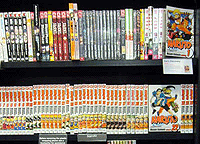
Recommending comments from shop staffs
Looking back at the last decade, the popularity of Manga in London has increased dramatically. Along with American comics and graphic novels, the Manga translated and published in English mainly in North America have established a genre of 'Manga' in the UK, and we can see that several shelves are dedicated to Manga in the major bookshops and local libraries. We can buy a book entitled 'DRAGON BALL', 'NARUTO', 'ONE PIECE' or 'NANA' for about £6. When we open the back cover of the book, which is the front cover in the West, we encounter some warnings, such as 'STOP! You're reading in the wrong direction!' to avoid readers being disappointed by seeing the last scene of the book written in the right-to-left style, or instructions showing the order for reading the word-balloons. The story of the book remains the same as in the original. It reminds me that those basic rules themselves are part of Japanese culture.
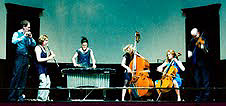
Music workshop leaders: Ignite
(Photo by Benjamin Harte)
The workshop 'Music 'N' Manga' took the form of a collaboration: Chie talked and led the workshop on Manga in the first half, while the second half was the music workshop led by Ignite, and the young people gave a concert at the end of the day. Ignite is a resident ensemble at Wigmore Hall, and plays in the concerts, leads workshops, devises programmes and composes music for many of the Wigmore Hall Learning projects. 26 young people attended the workshop, including a group of school children accompanied by their teacher. Most of them seemed to have read Manga before.
Chie explained the subject to the young people as follows, showing them real Manga books and magazines, 'When writing Japanese Manga, expressing the feelings and thoughts of the characters is one of the most important things. So, creating characters is a crucial task. Let's create your own characters!' Then they made a list about the character: Name, Gender, Age, Build, Hairstyle, Costume, Profession, Special Power, First Impression, and Other Characteristics.
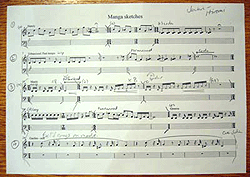
Ignite's composition 'Manga sketch'
According to Chie, 'As it was a workshop aiming at making music rather than writing Manga, I asked the young people to think deeply about the 'first impression', which would help them to create the music. I advised them not to describe it just by the word 'cool', but to think about deepening the personality by thinking, 'Is the first impression true to the real personality?' and so forth. 'Other characteristics' are usually about 'pets, partners or weapons', however, this time, I asked them to think about musical instruments that suit the character'.
Elizabeth told me that, 'We discussed how to do the workshop. When I heard Chie talking about how important creating characters is, I thought that Manga and music are similar in the creating process. Then, by discussing with Jackie from Ignite and Chie, we decided to follow the procedure of the young people creating their own Manga characters and making music based on them. Adopting existing stories from Manga was another option, but it might restrict the young people's musical imagination to the Asian prototype. We rather thought that it would be more exciting for them to create characters from scratch and make music for them'.
With pens and paper in hand, the young people started to draw pictures of the characters which they created: a cool boy with spikey hair holding a guitar as his weapon, a cute girl with cats' ears, a character waving xylophone sticks like a magic wand, and so on. Looking back, Chie said, 'I told them at the beginning that there were a lot of characters in Japanese Manga who you could see yourself in, you wanted to be friends with, or you wanted to know more about. Accordingly, the characters they created were quite similar to themselves; for example, they were based on themselves but had special powers which enabled them to do what they could not do in real life'.
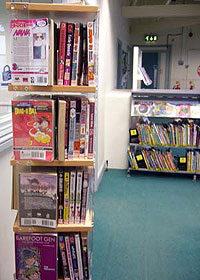
Manga section in a public library
After everyone had given a presentation about each character, four characters were chosen to be the theme of the music which they were going to compose. Ignite played their composition based on their characters as an example. At first, one theme tune was composed by the whole group. Following that, the young people were divided into four groups and each group devised a theme tune for the chosen character, exchanging ideas about the melodies and rhythms with each other with the help of Ignite.
The character of one group was 'a cute girl who can transform herself into any kind of animal and goes out at night to rescue animals in trouble'. Reflecting those characteristics, her theme tune started with some pretty touches, and then it turned into a tiptoeing part at night and a comical part of chatting with animals. It was expressed through the mood of the melodies and the combination of musical instruments, loud and quiet, and fast and slow.
'It was as if it were magic, especially for me, who expresses things by drawing, to witness how the characteristics of the Manga characters turned into the characteristics of the music!' Chie said. Elizabeth valued the process, saying that, 'Setting a character as the basis of the composition gave the young people clear ideas about how rhythm, melody and musical texture can change the characteristics of the music. That process improved the quality of the composition'. Both of them were inspired by each other.
At the end of the day, the young people moved into the hall to rehearse and performed their brand new piece on stage for their families. Chie drew bigger images of the characters for display at the front of the stage, along with a big picture drawn by the young people who were eager to draw more.
The theme of the opening tune was a girl who can control the weather. Various musical instruments, which the young people had brought or borrowed from Wigmore Hall, were added one by one to the tune. There were violins, horns, flutes, clarinets , guitars, double basses, drums, maracas, cymbals, bells, giros, xylophones, glockenspiels and a piano, and a big ensemble of 31 people. Then each of the four groups introduced the picture, name, personality and super power of their Manga character, and performed their composition in turn. It was impressive to see the bright faces of the young people talking about the character they had created and showing their drawings to their families, shyly but proudly.
Report: Chigusa Futako


